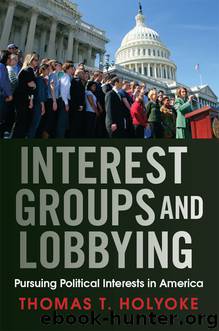Interest Groups and Lobbying by Holyoke Thomas T.;

Author:Holyoke, Thomas T.; [Holyoke, Thomas T.]
Language: eng
Format: epub
Publisher: Westview Press
FIGURE 7.2 Subgovernments and Issue Networks
Subgovernment, or iron triangle, is an important concept to understand, for it is a consequence of the relationships lobbyists build with legislators discussed in the last chapter. In the middle portion of Figure 7.2, the five legislators on a subcommittee are marked with Ls by where they would ideally like to see policy enacted on a liberal to conservative continuum of possible policy outcomes (like the hours of driving continuum in chapter 5). Interest groups concerned with the policy in the subcommittee’s jurisdiction are listed as IGs. Their positions on the continuum reflect the desires of their members, who are the same constituents who keep the subcommittee legislators in office, which is why they are shown together on the same continuum in Figure 7.2. The upper continuum (middle of the figure) depicts a subgovernment layout, where a majority of legislators and interest groups agree on what policy should be and establish an agency with a mission to implement it at point A. Lobbyists for interest groups 1 through 4 are welcome at this agency because they share the same values as agency staff and desire to serve the same constituencies as the subcommittee legislators. Sometimes this means implementing the absurd. To make it easy to build a water system for Los Angeles, interest groups and irrigation subcommittee legislators easily convinced the US Forest Service to designate some scrub land as the Inyo National Forest so Reclamation could build a canal so L.A. could drain all of the water out of the Owens Valley in eastern California (Reisner 1986). Of course legislator L5 and ally IG5 are not happy, but their desires are considered far out of the mainstream and therefore excluded from subcommittee business and ignored by the agency.
Over time things may change. New interests championed by new legislators may find their way on to the subcommittee overseeing the agency and advocate for a new, perhaps radically different, policy. The result, displayed at the bottom of Figure 7.2, is more dispersed legislator-interest group preference pairs on the subcommittee, creating conflict where there had once been consensus. Any decision agency officials make now will displease somebody on the subcommittee, and may not please anybody. Oddly enough, though, the result of this subgovernment disintegration into what is called an issue network (Heclo 1978) is greater agency independence. The agency is now free to continue pursuing its original mission because the subcommittee’s new members and their new lobbyist allies are not unified enough to use the lawmaking process to force the agency to do what they want (Niskanen 1971). That is why the agency’s position, A, on the lower continuum is still the same as on the upper continuum. New staff members are still socialized into the agency’s culture and will continue to implement policy in line with the original mission (Downs 1967). Groups whose interests still align with the agency’s original mission continue to enjoy privileged access there. From everyone else’s point of view, though, the agency has gone rogue.
Download
This site does not store any files on its server. We only index and link to content provided by other sites. Please contact the content providers to delete copyright contents if any and email us, we'll remove relevant links or contents immediately.
The Secret History by Donna Tartt(16606)
The Social Justice Warrior Handbook by Lisa De Pasquale(11485)
Thirteen Reasons Why by Jay Asher(7779)
This Is How You Lose Her by Junot Diaz(5751)
Weapons of Math Destruction by Cathy O'Neil(5027)
Zero to One by Peter Thiel(4815)
The Myth of the Strong Leader by Archie Brown(4784)
Promise Me, Dad by Joe Biden(4439)
Stone's Rules by Roger Stone(4409)
Beartown by Fredrik Backman(4399)
How Democracies Die by Steven Levitsky & Daniel Ziblatt(4391)
The Fire Next Time by James Baldwin(4336)
100 Deadly Skills by Clint Emerson(4070)
A Higher Loyalty: Truth, Lies, and Leadership by James Comey(4024)
Rise and Kill First by Ronen Bergman(4008)
The David Icke Guide to the Global Conspiracy (and how to end it) by David Icke(3875)
The Farm by Tom Rob Smith(3869)
Secrecy World by Jake Bernstein(3773)
The Doomsday Machine by Daniel Ellsberg(3725)
